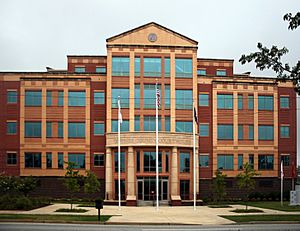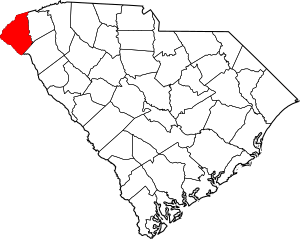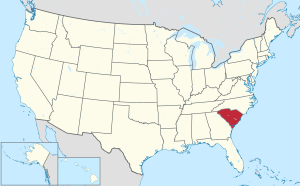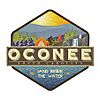Oconee County, South Carolina facts for kids
Quick facts for kids
Oconee County
|
|||||
|---|---|---|---|---|---|

Oconee County Courthouse in Walhalla
|
|||||
|
|||||
| Nickname(s):
Land Beside The Water
|
|||||

Location within the U.S. state of South Carolina
|
|||||
 South Carolina's location within the U.S. |
|||||
| Country | |||||
| State | |||||
| Founded | 1868 | ||||
| Named for | Cherokee word for "land beside the water" | ||||
| Seat | Walhalla | ||||
| Largest community | Seneca | ||||
| Area | |||||
| • Total | 673.57 sq mi (1,744.5 km2) | ||||
| • Land | 626.56 sq mi (1,622.8 km2) | ||||
| • Water | 47.01 sq mi (121.8 km2) 6.98% | ||||
| Population
(2020)
|
|||||
| • Total | 78,607 | ||||
| • Estimate
(2023)
|
81,221 | ||||
| • Density | 125.46/sq mi (48.44/km2) | ||||
| Time zone | UTC−5 (Eastern) | ||||
| • Summer (DST) | UTC−4 (EDT) | ||||
| Congressional district | 3rd | ||||
Oconee County is the westernmost county in the U.S. state of South Carolina. It is known for its beautiful lakes and forests. In 2020, about 78,607 people lived here.
The main town, called the county seat, is Walhalla. The biggest community in the county is Seneca. Oconee County is part of a larger area that includes cities like Greenville and Spartanburg. South Carolina Highway 11, also known as the Cherokee Foothills National Scenic Highway, starts in Oconee County near the Georgia border.
Contents
History of Oconee County
Oconee County gets its name from a historic Cherokee town. The word "Ae-quo-nee" means "land beside the water." The original Oconee town was located near a trading path. This path was used in the early 1700s for trade between Charleston and the Mississippi River.
The Cherokee people built special town houses and council houses. These were meeting places for the community. Over many years, they would rebuild these structures and add to nearby mounds of earth.
Because of its location, Oconee town was important for trade and treaties. In 1792, the South Carolina State Militia built a fort nearby called Oconee Station.
European settlers did not move into this area until after the American Revolutionary War. Oconee County was officially created in 1868. This was after the American Civil War. It was formed from part of the Pickens District. Walhalla became the county seat.
Key Moments in Oconee County History
- 1780s: The rare American wildflower, Oconee Bell, was first found here.
- 1780s: Revolutionary War soldiers received land grants and settled in the area.
- 1787: Georgia gave up its land claims in this region to South Carolina.
- 1816: The Cherokee sold their remaining land in South Carolina.
- 1850s: Tunnel Hill was the largest town, located near Stumphouse Mountain Tunnel.
- 1868: Oconee County was officially formed. Walhalla became the county seat.
- 1870: A new railroad was built, helping towns like Seneca and Westminster grow.
- 1893: Newry was built as a village for textile mill workers.
Oconee County Today
Today, people living in Oconee County often call it the "Golden Corner." This name comes from its location as the northwesternmost county in South Carolina.
Geography and Nature
Oconee County covers about 673.57 square miles. Most of this is land, but about 47 square miles are water. The county has three large man-made lakes. These lakes are great for sport fishing, water skiing, and sailing. They also help create hydroelectric power, which is electricity made from moving water.
The largest lake is Lake Hartwell. It was built between 1955 and 1963. Lake Keowee is the second largest. The Oconee Nuclear Station is located near this lake. Lake Jocassee is the third largest. It is also a source of hydroelectric energy and is known for its beautiful waterfalls.
Bad Creek Reservoir is in the mountains above Lake Jocassee. It is used to generate electricity during busy times. The water level can change quickly, so boating and swimming are not allowed there. Oconee County is part of the Savannah River basin.
Protected Natural Areas
Oconee County has several protected natural areas where you can enjoy the outdoors:
- Ellicott Rock Wilderness (part)
- Sumter National Forest (part)
State and Local Parks and Sites
- Brasstown Creek Heritage Preserve/Wildlife Management Area
- Buzzard Roost Heritage Preserve/Wildlife Management Area
- Chau Ram County Park
- Devils Fork State Park
- High Falls County Park
- Horsepasture River
- Lake Hartwell State Recreation Area
- Oconee State Park
- Oconee Station State Historic Site
- Piedmont Forestry Center
- Poe Creek State Forest (part)
- South Cove County Park
- Stumphouse Mountain Heritage Preserve/Wildlife Management Area
- Sumter National Forest - Andrew Pickens Ranger District
- W.P. Anderson City Park
- Yellow Branch Falls Recreation Area
Major Rivers and Lakes
Neighboring Counties
- Jackson County, North Carolina – north
- Transylvania County, North Carolina – northeast
- Pickens County – east
- Anderson County – southeast
- Hart County, Georgia – south
- Franklin County, Georgia – south
- Stephens County, Georgia – southwest
- Habersham County, Georgia – west
- Rabun County, Georgia – west
- Macon County, North Carolina – northwest
Main Roads and Transportation
 I-85
I-85 US 76
US 76 US 123
US 123 SC 11
SC 11 SC 24
SC 24 SC 28
SC 28 SC 59
SC 59 SC 107
SC 107 SC 130
SC 130 SC 182
SC 182 SC 183
SC 183 SC 188
SC 188 SC 243
SC 243
Important Facilities
- Oconee County Regional Airport
Population and People
| Historical population | |||
|---|---|---|---|
| Census | Pop. | %± | |
| 1870 | 10,536 | — | |
| 1880 | 16,256 | 54.3% | |
| 1890 | 18,687 | 15.0% | |
| 1900 | 23,634 | 26.5% | |
| 1910 | 27,337 | 15.7% | |
| 1920 | 30,117 | 10.2% | |
| 1930 | 33,368 | 10.8% | |
| 1940 | 36,512 | 9.4% | |
| 1950 | 39,050 | 7.0% | |
| 1960 | 40,204 | 3.0% | |
| 1970 | 40,728 | 1.3% | |
| 1980 | 48,611 | 19.4% | |
| 1990 | 57,494 | 18.3% | |
| 2000 | 66,215 | 15.2% | |
| 2010 | 74,273 | 12.2% | |
| 2020 | 78,607 | 5.8% | |
| 2023 (est.) | 81,221 | 9.4% | |
| U.S. Decennial Census 1790–1960 1900–1990 1990–2000 2010 2020 |
|||
Population in 2020
| Race / Ethnicity (NH = Non-Hispanic) | Pop 2000 | Pop 2010 | Pop 2020 | % 2000 | % 2010 | % 2020 |
|---|---|---|---|---|---|---|
| White alone (NH) | 58,259 | 63,807 | 64,696 | 87.98% | 85.91% | 82.30% |
| Black or African American alone (NH) | 5,533 | 5,550 | 5,119 | 8.36% | 7.47% | 6.51% |
| Native American or Alaska Native alone (NH) | 133 | 152 | 176 | 0.20% | 0.20% | 0.22% |
| Asian alone (NH) | 232 | 421 | 591 | 0.35% | 0.57% | 0.75% |
| Native Hawaiian or Pacific Islander alone (NH) | 7 | 8 | 16 | 0.01% | 0.01% | 0.02% |
| Other race alone (NH) | 45 | 41 | 182 | 0.07% | 0.06% | 0.23% |
| Mixed race or Multiracial (NH) | 444 | 945 | 3,443 | 0.67% | 1.27% | 4.38% |
| Hispanic or Latino (any race) | 1,562 | 3,349 | 4,384 | 2.36% | 4.51% | 5.58% |
| Total | 66,215 | 74,273 | 78,607 | 100.00% | 100.00% | 100.00% |
In 2020, there were 78,607 people living in Oconee County. There were 31,530 households and 21,214 families.
Population in 2010
In 2010, the county had 74,273 people. Most people were white (87.8%), followed by black or African American (7.6%). About 4.5% of the population was of Hispanic or Latino origin.
Of the households, 28.2% had children under 18. The average household had 2.40 people. The average age of people in the county was 43.4 years. The average income for a family was $52,332. About 16.6% of the population lived below the poverty line.
Economy and Jobs
In 2022, the total value of all goods and services produced in Oconee County was about $4.5 billion. This is called the GDP.
Many people work in Oconee County. Some of the largest employers include:
- Apex Tool Group
- BorgWarner
- CSL Plasma
- Duke Energy
- Ingles
- Itron
- Kelly Services
- Prisma Health
- Sandvik
- Schneider Electric
- Walmart
Jobs and Wages in Oconee County (2023)
| Industry | Employment Counts | Employment Percentage (%) | Average Annual Wage ($) |
|---|---|---|---|
| Accommodation and Food Services | 2,150 | 9.5 | 20,332 |
| Administrative and Support and Waste Management and Remediation Services | 1,264 | 5.6 | 49,244 |
| Agriculture, Forestry, Fishing and Hunting | 134 | 0.6 | 30,108 |
| Arts, Entertainment, and Recreation | 650 | 2.9 | 21,008 |
| Construction | 1,665 | 7.4 | 51,688 |
| Finance and Insurance | 587 | 2.6 | 67,860 |
| Health Care and Social Assistance | 2,887 | 12.8 | 64,636 |
| Information | 342 | 1.5 | 59,540 |
| Management of Companies and Enterprises | 10 | 0.0 | 82,212 |
| Manufacturing | 5,598 | 24.8 | 65,312 |
| Other Services (except Public Administration) | 835 | 3.7 | 37,700 |
| Professional, Scientific, and Technical Services | 760 | 3.4 | 67,288 |
| Public Administration | 1,174 | 5.2 | 47,164 |
| Real Estate and Rental and Leasing | 254 | 1.1 | 48,776 |
| Retail Trade | 3,628 | 16.0 | 33,904 |
| Transportation and Warehousing | 194 | 0.9 | 57,564 |
| Wholesale Trade | 476 | 2.1 | 62,348 |
| Total | 22,608 | 100.0% | 50,300 |
Communities in Oconee County
Oconee County has several cities, towns, and other communities.
Cities
- Seneca (the largest community)
- Walhalla (the county seat)
- Westminster
Towns
Census-Designated Places
These are areas that are like towns but are not officially incorporated as one.
- Chickasaw Point
- Fair Play (partly in Anderson County)
- Keowee Key
- Longcreek
- Newry
- South Union
- Tamassee
- Utica
Unincorporated Communities
These are smaller communities that are not part of any city or town.
- Corinth
- Madison
- Mountain Rest
- Oakway
- Picket Post
- Richland
- Tokeena Crossroads
- Townville (partly in Anderson County)
See also
In Spanish: Condado de Oconee (Carolina del Sur) para niños




